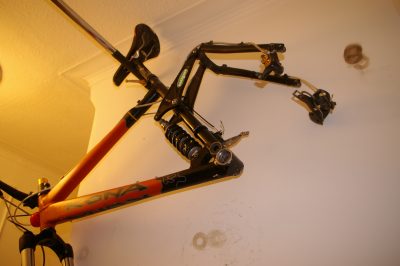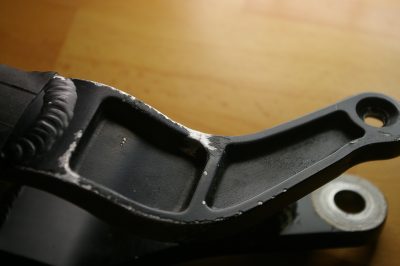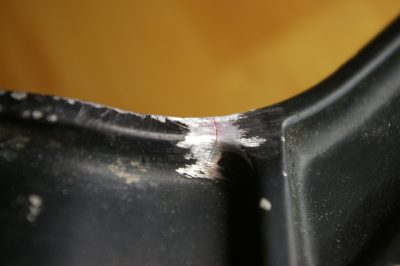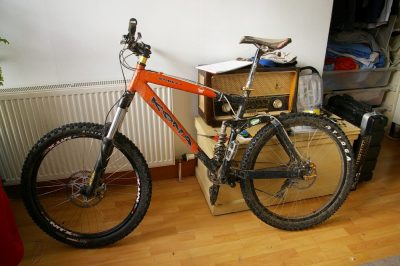This is a message to my brother, whom I’ve literally not seen or heard from in years, and whose birthday it happens to be today. So happy birthday from me, mum and dad! Hope you, Rowanna and the kids are doing well. And please get in touch, since none of us has a clue where in the world you are or what you’re doing…steve
Blog
-
Carron Valley in black double diamond shocker!
I was doing some reading on the failure of the Carron Valley trails project, when I came across this… Funniest thing I’ve seen all week! Black diamond grade? Doubles with aggressive faces? Massive air?!
Are we talking about the same Carron Valley here?
I ask you, ladies and gentlemen of the jury, is this really “massive air”?

And if that was massive air, then what’s this?!
Or were CVDG simply stitched up by the 7Stanes crew?
-
We’re moving to WordPress!
It’s been decided! From now on, I’m going to use WordPress as the content management system for everything. The old bare HTML site will not be updated any more, and the scopeblog will become the front page. You’ll be able to find the most popular parts of the old site through the sidebar ———->
-
Some smileys of Greek Legend
Sisyphus: (\")-O
Tantalus: (\")-----{ º
Trojan Horse: (----:}=(, :] :] :] ,)-
Icarus: *~~~ > 8-O <
-
Kona name their bikes after farts
So I guess it’s only appropriate that I cracked one.
While dismantling the back end to renew the swingarm bearings (which turned out to be completely shot)

Oh noes, what’s this funny little lump in the paint? I ground the paint off to reveal…

A nasty little crack 🙁 Oh well, this explains the creaking noises that were coming from the back end last season.

I have no idea how this happened. Stinkies are supposed to be tough, and the previous owner didn’t seem like the kind of guy who would huck off his garage roof all day. And I didn’t ride off anything that big, either! This part of the frame seems to be exposed to a lot of bending forces from chain tension, so maybe it just came to the end of its fatigue life.
Or maybe I’m just rad to the edge of sickness.
-
ode to e.e. cummings
one day while he was typing
e.e. cummings got a shock
where once had stood a SHIFT key
was a little pointy stalkhe cut his finger on it
and was so irate (it’s said)
that he never touched another
till the day he fell down dead -
To my online friends…
If you haven’t seen me around in a while, read this.
http://www.cracked.com/article_15231_7-reasons-21st-century-making-you-miserable.html
-
Error codes of history
-100,000: Come down from the trees? [Yes|No]
-99,999: Are you sure? This operation cannot be undone.
…….
1066: Invalid media in I: (Fatal)
1492: Unexpected “Indians” in atlantic.c
1690: Oppress any Catholic to continue
1861-1865: Slave not responding
1920: Distiller performed an illegal operation and will be closed.
1939-1945: You must be an administrator to install the Third Reich.
……
2000 and above: Volume “La-Z-Boy” is full. Please delete some of your beer gut and try again.
-
When a man is tired of tires…
Yes, another gripping blog post about bicycle tires!
First of all, big up the Bontrager Hard Case, a “puncture-proof” tyre for road bikes. I put them on my commuter bike and have had 0 punctures so far, down from an average of 2 per week with the stock tyres.
Second, fat rims need fat tyres! I run Sun Mammoth rims on my Stinky, and Alastair at Wheelcraft persuaded me that it’s OK to run regular sized MTB tyres on them. His “loaf of bread theory” is that the tyre works better sat inside a wide rim like a loaf of bread in a baking tin, than bulging out of a narrow rim like a Starbucks muffin. Well, he’s wrong. I put a 2.5″ Big Earl on the front, in place of the old 2.25″ tyre, and the bike corners so much better it’s unreal. I think the narrower tyre ends up with a flattened tread profile that stops the contact patch from assuming the right shape when you lean into a corner. Like putting a car tyre on your motorbike. It kind of works on the back, but you wouldn’t want it on the front.
Finally, an apology to the Conti Gravity tyre that I bitched about a few posts ago. I got hate mail from someone who lives next door to the Conti factory 😉 I put it on the front of my Inbred and it works great. It’s just a bit wussy to be a back tyre on a freeride bike.

